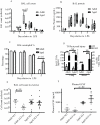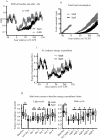Aging Influences the Metabolic and Inflammatory Phenotype in an Experimental Mouse Model of Acute Lung Injury
- PMID: 32997738
- PMCID: PMC8087268
- DOI: 10.1093/gerona/glaa248
Aging Influences the Metabolic and Inflammatory Phenotype in an Experimental Mouse Model of Acute Lung Injury
Abstract
Increased age is a risk factor for poor outcomes from respiratory failure and acute respiratory distress syndrome (ARDS). In this study, we sought to define age-related differences in lung inflammation, muscle injury, and metabolism after intratracheal lipopolysaccharide (IT-LPS) acute lung injury (ALI) in adult (6 months) and aged (18-20 months) male C57BL/6 mice. We also investigated age-related changes in muscle fatty acid oxidation (FAO) and the consequences of systemic FAO inhibition with the drug etomoxir. Aged mice had a distinct lung injury course characterized by prolonged alveolar neutrophilia and lack of response to therapeutic exercise. To assess the metabolic consequences of ALI, aged and adult mice underwent whole body metabolic phenotyping before and after IT-LPS. Aged mice had prolonged anorexia and decreased respiratory exchange ratio, indicating increased reliance on FAO. Etomoxir increased mortality in aged but not adult ALI mice, confirming the importance of FAO on survival from acute severe stress and suggesting that adult mice have increased resilience to FAO inhibition. Skeletal muscles from aged ALI mice had increased transcription of key fatty acid metabolizing enzymes, CPT-1b, LCAD, MCAD, FATP1 and UCP3. Additionally, aged mice had increased protein levels of CPT-1b at baseline and after lung injury. Surprisingly, CPT-1b in isolated skeletal muscle mitochondria had decreased activity in aged mice compared to adults. The distinct phenotype of aged ALI mice has similar characteristics to the adverse age-related outcomes of ARDS. This model may be useful to examine and augment immunologic and metabolic abnormalities unique to the critically ill aged population.
Keywords: Critical illness; Fats; Inflammation; Nutrition.
© The Author(s) 2020. Published by Oxford University Press on behalf of The Gerontological Society of America. All rights reserved. For permissions, please e-mail: journals.permissions@oup.com.
Figures



References
-
- Ely EW, Wheeler AP, Thompson BT, Ancukiewicz M, Steinberg KP, Bernard GR. Recovery rate and prognosis in older persons who develop acute lung injury and the acute respiratory distress syndrome. Ann Intern Med. 2002;136(1):25–36. - PubMed
Publication types
MeSH terms
Substances
Grants and funding
LinkOut - more resources
Full Text Sources
Medical

